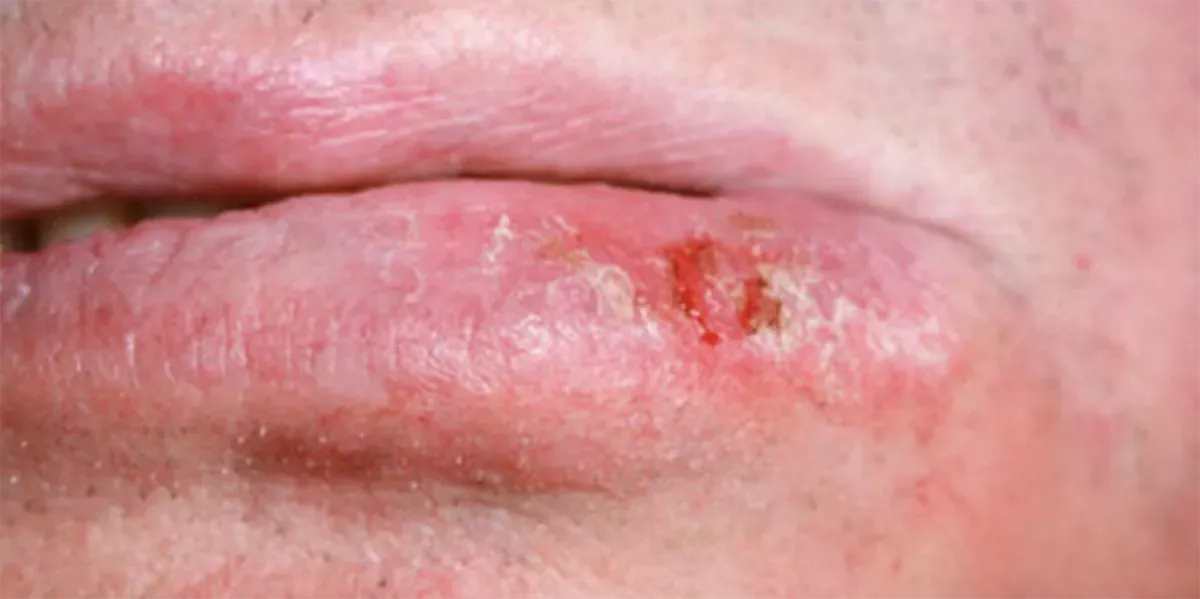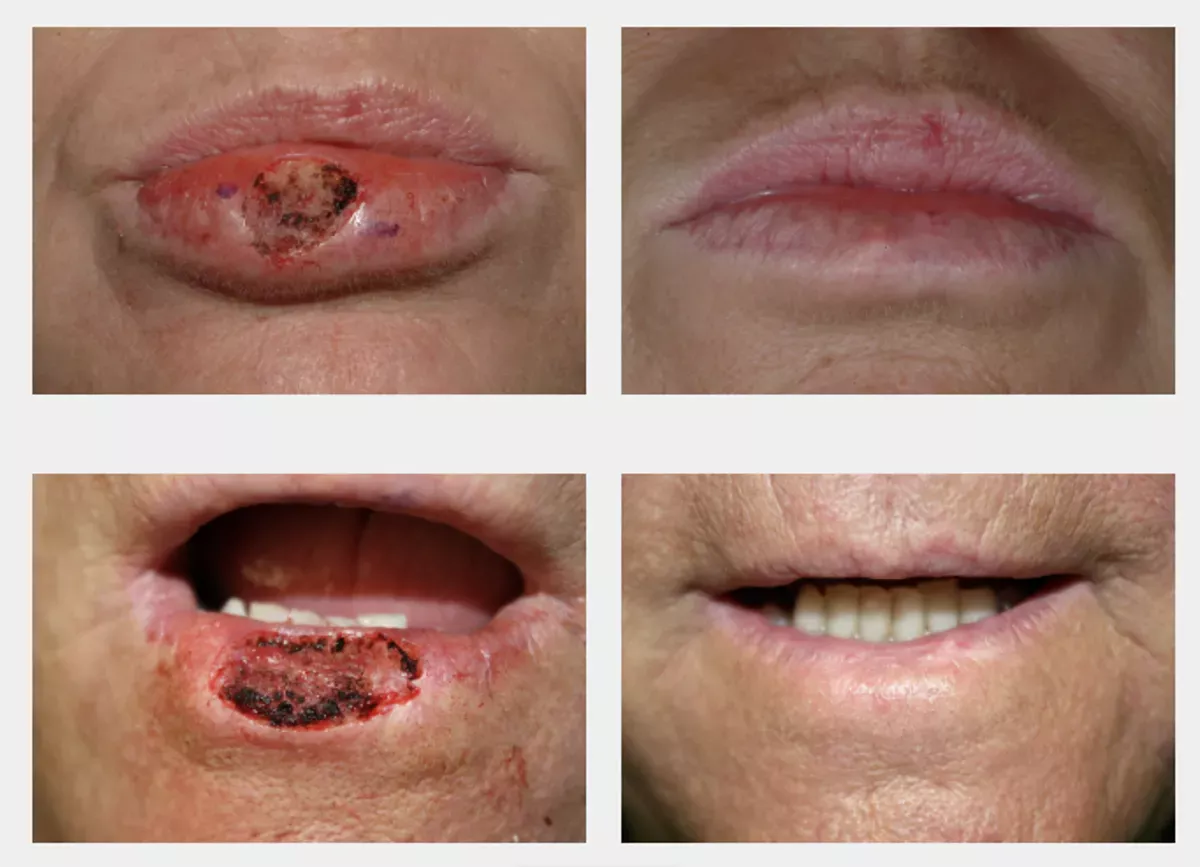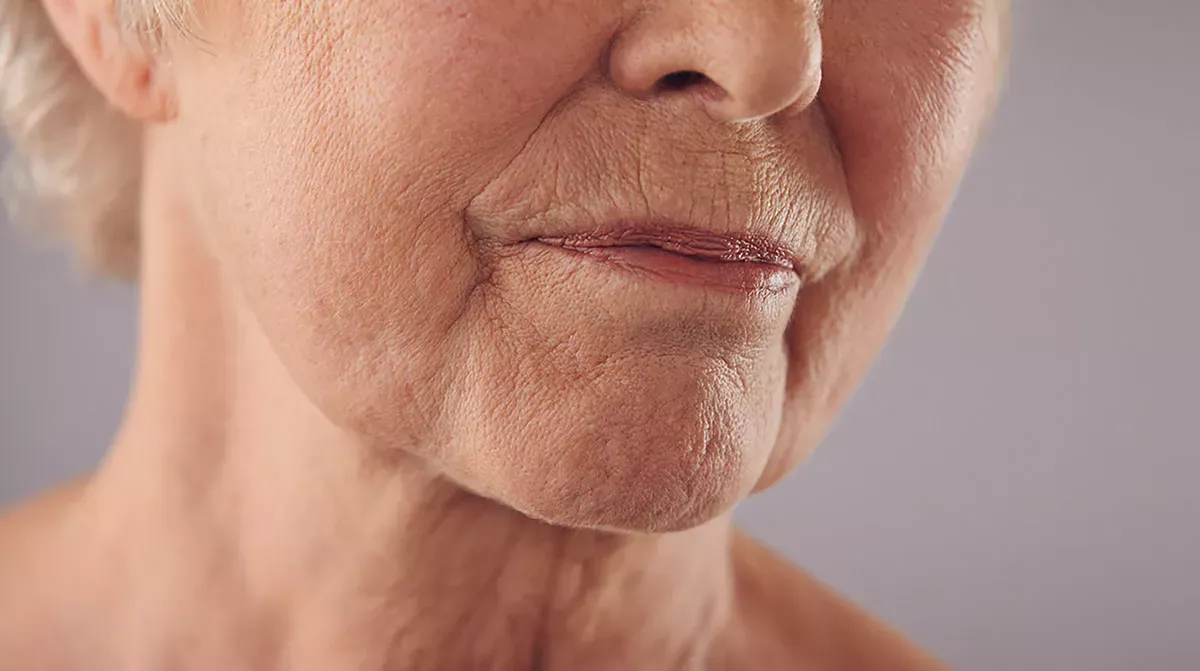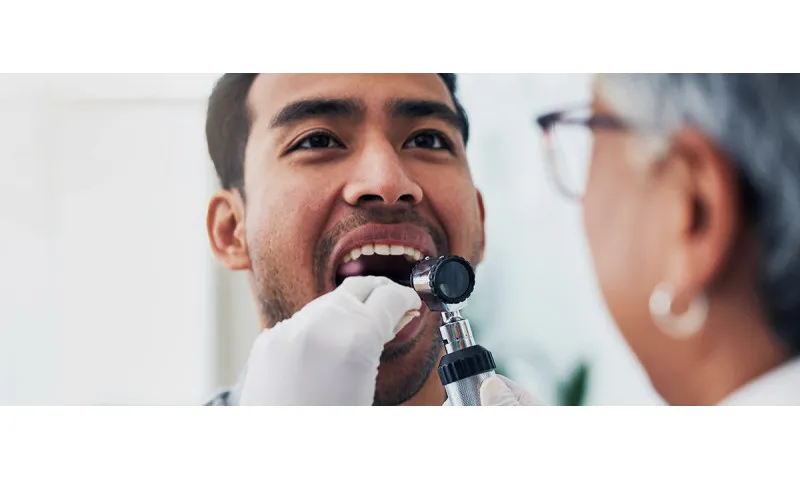Definition: What is lip cancer?
Lip cancer (technical term: squamous cell carcinoma of the lip) is a malignant tumour in the lip area. This type of cancer most commonly occurs on the side of the lower lip. The tumour has the potential to grow either inwards or outwards. Tumours on the lips, given their location at the junction of the oral mucosa and the skin, may be categorised as both oral cavity cancer and skin cancer.
The most common tumour in the oral cavity is the squamous cell carcinoma, which develops on the uppermost layer of the oral mucosa. As the lips are also covered by an epithelium (the transitional epithelium), a squamous cell carcinoma is also the most common form of lip cancer tumour and is also referred to as a "prickle-cell carcinoma". Basal cell carcinomas, which develop on the skin-coloured area adjacent to the upper lip rather than directly on the vermilion, are less common. Both of these forms of cancer are categorised as "white skin cancer". Even rarer are malignant melanomas, which are also known as "black skin cancer". This most aggressive form of skin cancer accounts for only 0.5 percent of all malignant oral cavity tumours.
Where does lip cancer occur?
According to the international classification ICD-10, lip cancer can occur on the following surfaces of the lip area:
- External upper lip (vermilion and vermilion border)
- External lower lip (vermilion and vermilion border)
- Inner side of the upper lip
- Inner side of the lower lip
- Corner of the mouth (lip commissure)
- Several overlapping areas
How dangerous is lip cancer?
Lip cancer is a mixed form of skin and oral cavity cancer: While it exhibits slower growth than carcinomas in other parts of the mouth, it spreads faster than squamous cell carcinomas on other areas of the skin. Even small lip carcinomas, if not removed promptly, have the potential to metastasise to the lymph nodes.
Frequency of lip cancer
According to the US National Cancer Institute, the rate of new cases of lip cancer is 0.5 per 100,000 men and women per year. This means that approximately 0.1 percent of individuals will be diagnosed with lip cancer at some point during their lifetime.
According to estimates by the Robert Koch-Institut, more than 600 people are diagnosed with lip cancer in Germany every year. The majority of sufferers are men aged between 75 and 85 years. Overall, men are more prone to develop lip cancer than women. Oral cavity cancer in general – and thus also lip cancer – is very rare among children.
Prognosis: What are the chances of surviving lip cancer?
Lip cancer is definitely curable – however, as with all other types of cancer, it is essential to recognise and treat the disease as early as possible. When identified in its early stages, the prognosis for lip cancer is very good. This is basically attributed to the gradual growth of the tumour, which results in the slow formation of metastases. The chances of recovering from lip cancer are nearly 100 percent if the tumour is smaller than five millimetres.
According to the US National Cancer Institute, the five-year survival rate for lip cancer is 90.9 percent. Given the highly visible location where lip cancer develops, approximately 77 percent of cases are caught at the local stage before spreading to the lymph nodes. In contrast, other oral cavity tumours are only detected early in 30 percent of cases. Roughly eight percent of lip cancer patients already have lymph node metastases at the time of diagnosis, resulting in a much lower five-year survival rate of around 62 percent. In about one percent of patients, distant metastases have already formed at diagnosis. The five-year survival rate in this case drops to roughly 38 percent. Lip cancer can also have a fatal outcome. No details were provided for a further 14 percent of sufferers.
Symptoms: How do you recognise lip cancer?
Lip cancer typically manifests through preliminary stages that may progress into a malignant tumour if left untreated. This is also referred to as precancerous conditions. Below you will find a description of the symptoms along with images illustrating both the early and advanced stages of lip cancer, including its preliminary stages.
Preliminary stages: How does lip cancer start?
The precancerous preliminary stages of lip cancer include:
Leukoplakia
Leukoplakia (a white plaque-like lesion) causes white patches to form on the lips that cannot be wiped off. This occurs since the affected areas experience faster keratinisation than the surrounding tissue. The moisture in the mouth causes the keratinised areas to swell and eventually turn white. Leukoplakias are usually harmless, but if they are not treated in time, they may develop into a malignant tumour. You should therefore have white patches on your lips looked at by a health care professional promptly.
Smoking, excessive alcohol consumption and poor oral hygiene are among the most common causes of leukoplakias in the mouth. That said, prolonged exposure to the sun can also lead to leukoplakias forming on the lips.
Actinic cheilitis
Actinic cheilitis (or actinisc ceratosis on the lips) is a precancerous lesion on the surface of the lips due to increased exposure to sunlight – especially UVB rays. It forms most commonly on the lower lip, as the upper lip is less exposed to the sun. Men and smokers are more at risk of developing the disease than non-smokers. If the inflammation becomes chronic, it develops into a squamous cell carcinoma.
Further possible preliminary stages of lip cancer:
- Lichen planus: An autoimmune disease that can affect the skin and mucous membranes, thereby leading to chronic inflammation
- Bowen's disease: Reddish, scaly or crusty patch on the skin that is considered to be a very early form of white skin cancer
- Xeroderma pigmentosum: A rare, genetic condition where the body is unable to repair skin damage caused by ultraviolet radiation (UVR)
- Chemical, physical or thermal trauma to the lips
Possible symptoms of the preliminary stages at a glance
If you notice any of the following symptoms, make an appointment with a dermatologist as soon as possible to rule out the possibility of lip cancer:
- Dry, scaly red patches on your lips
- White of dark patches on your lips
- Wart-like growths
- Burning lips
- Crusty patches on your lips
Indications: What does lip cancer look like?
If left untreated, the preliminary stage symptoms will go on to develop into lip cancer. Initially, an ulcer with a hard edge forms, which fails to heal and bleeds and, if not treated, will continue to spread as the disease progresses. Furthermore, there may also be swelling and pain in the affected area. Dark red lumps appear on the ulcer as time goes on.
Lip cancer in the advanced stage
If lip cancer is not diagnosed at an early stage, the tumour continues to grow. This may lead to the presence of metastases in the lymph nodes. This occurs more frequently with squamous cell carcinomas on the vermilion than with tumours that develop on the skin next to the lips. Overall, lip cancer metastasises less often than other types of oral cancer.
Moreover, the following symptoms are a possibility:
- Difficulties in chewing, swallowing and speaking
- Lethargy and chronic tiredness
- Unexplainable loss of weight and appetite
Metastases: How quickly does lip cancer spread?
Lip cancer grows very slowly. This is also a reason why over 70 percent of cases are diagnosed early and are highly treatable. However, lip cancer can spread and form metastases – initially in the lymph nodes. From there, the tumour cells spread and impact vital organs within the body.
Differentiation: What other lip diseases are there?
Not every skin blemish on the lips is lip cancer or an early form of the disease. There is a risk of confusing the following lip diseases with lip cancer:
Lip cancer or cold sore?
Cold sores are a symptom caused by the herpes simplex virus. In many cases, a cold sore starts with a burning or tingling sensation in the affected area. This is followed by blisters filled with fluid appearing on the lips. These blisters eventually burst, forming crusts or scabs around the mouth. Cold sores usually resolve on their own within a few weeks without the need for treatment. So, if you notice an abnormality on your lips that fails to disappear after a fortnight, go and have it looked at by a dermatologist as a precaution and never try to treat the symptom yourself. By the way, unlike cold sores, lip cancer is not contagious.
Read more: What are cold sores and what can you do about them?
Syphilis
Syphilis is actually a sexually transmitted disease and, therefore, usually appears on the genitals. What many people do not know: Primary syphilis can also be transmitted through oral sex and present itself on the lips and tongue or in the throat. The disease starts as a painless sore at the point of entry of the bacterium and eventually develops into an ulcer. This ulceration is – in contrast to lip cancer – painless and does not bleed. It is also firm to the touch.
Peutz-Jeghers syndrome and Morbus Addison
Patients with these systemic diseases often develop small, dark-coloured spots on the lips which could be mistaken for a malignant melanoma. Further, harmless pigment lesions may also appear on the lips. In any case, you should always have suspicious skin blemishes examined by a doctor.
Causes: What causes lip cancer?
Lip cancer develops when cells with altered genetic information are not identified and destroyed by the immune system and start to multiply. Since tumour cells divide faster than normal ones, they gradually displace more and more healthy cells, which allows for tumour progression. It is not yet fully known why this type of cell mutation occurs. Genetic factors may play a role. There are, however, a number of risk factors that favour the development of lip cancer.
Risk factors
Smoking tobacco and drinking alcohol are considered the main risk factors for most mouth cancers. However, since the lips surround the orifice of the mouth, there is another key risk factor related to lip cancer: Intense sunlight.
UV radiation
When we are exposed to too much UV radiation (especially UVB radiation) from the sun, it can damage the DNA in our skin cells. If the lips are repeatedly exposed to intense sunlight over many years, there is a chance of lip cancer developing. This typically manifests through the aforesaid preliminary stages. Anyone can develop lip cancer, but people over the age of 45 with fair skin who burn more easily have a higher risk. Someone with darker skin is less likely to develop the disease.
Smoking tobacco and drinking alcohol
The toxic substances in tobacco smoke also damage the vermilion and thus increase the risk of developing lip cancer – especially in combination with the regular consumption of alcohol. While the use of tobacco combined with high-proof alcohol is the main risk factor for all oral cavity cancers, pipe smoking is particularly linked to lip cancer. This is probably due to the fact that a pipe is permanently in contact with the lips. A study has also shown that individuals who keep cigarettes in their mouths while smoking, instead of holding them between their fingers or putting them down, face a higher risk of developing lip cancer.
Weakened immune system
Patients who have to take immunosuppressive drugs after undergoing an organ transplant also have an increased risk of developing cancer. Individuals who have received a transplant usually need to take these drugs to reduce the risk of their body rejecting the new organ. Unfortunately, this also makes life easier for mutated cancer cells. For example, the risk of lip cancer is 30 percent higher after a kidney transplantation.
ACE inhibitors
Individuals with fair skin who suffer from elevated blood pressure and take ACE inhibitors should be particularly careful in the summer. Some of these products increase the UV sensitivity of the skin, and excessive sun exposure can trigger lip cancer.
Poor oral hygiene
If you fail to brush your teeth thoroughly, there is an increased risk of gum inflammation, dental decay and periodontitis. If these diseases are not treated in time and the inflammation spreads, they can also attack the tissue of the lips and cause lip cancer.
Good to know:
Even though we brush our teeth daily, we frequently make inadvertent mistakes without realising it. The following article explains the proven best techniques for each toothbrushing routine:
Diagnosis: Which health care professional diagnoses lip cancer?
If you notice a worrisome blemish on your lips, a dermatologist or your family doctor should be your first point of contact. They might then refer you to a specialist – for example, an oral and maxillofacial surgeon or an oncologist (cancer specialist). Dentists quite often detect lip cancer during routine check-ups.
The first step in diagnosing lip cancer is a biopsy. This involves a doctor taking a small tissue sample while the affected area is numbed and sending it off to a laboratory for testing. This sample can be used to identify whether lip cancer is actually present and to establish the type of tumour. If there is indeed a malignant tumour on the lip, imaging examinations are typically conducted to assess how large the tumour is and whether it has already spread to neighbouring tissue – for example to the floor of the oral cavity – or has metastasised to the lymph nodes.
The following examinations may be applied:
- Computed tomography (CT) scan
- Magnetic resonance imaging (MRI) scan
- Ultrasonic examination of the lymph nodes
- X-ray imaging of the jawbones
The specialist then uses the examination results to classify the tumour. More information on classification of the tumour can be found in our main article on oral cavity cancer:
Treatment: What to do about lip cancer?
The exact treatment for lip cancer depends greatly on the stage of the tumour and what type of tumour it is. The best possible treatment for each individual case is discussed by a team of specialists from various medical disciplines who collaborate in meetings known as tumour conferences or tumour boards.
Surgery
The lip cancer ulcer usually has to be surgically removed to stop it spreading. The surgeon excises not only the affected area but also clinically healthy surrounding tissue with a margin of at least one centimetre to prevent invisible tumour cells from remaining in the lip and forming a new tumour (recurrence).
Reconstruction
Besides being required for essential bodily functions, such as chewing, eating and swallowing, the lips are also necessary for communication: We use them to laugh and talk. Reconstructive procedures are necessary after lip cancer surgery to make the appearance of the face as natural as possible. Tissue can be taken from other parts of the body to replace the missing part of the lip. Fortunately, modern technology enables surgeons to reconstruct and enhance both functional and aesthetic aspects.
Good to know:
Brushing your teeth after oral surgery can be extremely unpleasant and painful. Luckily, the CS Surgical toothbrush from Curaprox with its super soft filaments has been specifically designed for oral care after surgery.
Radiation treatment
With larger tumours, it may be advisable to undergo radiotherapy in addition to surgery. Either only the lips or also the lymph nodes can be irradiated. Radiotherapy is rarely employed prior to surgery, as the irradiated tissue could cause uncontrollable bleeding during a subsequent surgical procedure. Sometimes, radiotherapy might be sufficient to cure relatively small tumours without the need for surgery.
Chemotherapy and immunotherapy
Combining chemotherapy and radiotherapy may help to make cancer treatment more effective. However, chemotherapy is usually only used to combat lip cancer in an advanced stage when other treatment options no longer make sense, and a cure is no longer to be expected. In this case, the goal is not to fully remove the tumour but to improve a patient's quality of life and provide relief from pain and other distressing symptoms.
Good to know:
Find more information on the various treatment methods and their side effects as well as supporting treatment measures in our main article:
Preventative measures: How can you prevent lip cancer?
The best protection against lip cancer is to eliminate the risk factors as far as possible. This basically means:
Adopt good sun-protection habits
Fair-skinned people, in particular, who are at greater risk of sunburn, should shield their skin from direct sun exposure. Use a lip balm with a high sun protection factor or wear a wide-brimmed hat when on the beach. People who work outdoors and spend extended periods in the sun should also use lip balm with a high sun protection factor and apply sunscreen to their faces.
Adopt a healthy lifestyle
Smokers are more at risk of developing lip cancer – and all other types of oral cancer – than non-smokers. Especially in combination with the regular consumption of alcohol. If you smoke and consume high-proof alcoholic drinks on a regular basis, you should perhaps consider kicking these habits. Your liver and lungs will also be truly grateful.
Good to know:
Would you like to stop smoking but are not quite sure how? Helpful tips to do this are provided in our article:
Attend routine dental check-ups
Dentists often detect oral cancer during routine check-ups. If you attend routine dental check-ups, dangerous inflammation can be prevented in the first place.
Pay attention to good dental hygiene
Seeing as poor oral hygiene can also cause lip cancer, always take good care of your teeth and gums.
The most important information for a good daily oral hygiene routine at a glance:
- Make sure to brush your teeth for at least three minutes twice a day – in the morning after breakfast and at night before going to bed.
- For the best results, use a soft toothbrush to avoid damaging your gums – for example, the CS 5640 from Curaprox
- Always use a toothpaste with fluoride to protect your teeth against dental decay – for example, the ‘Be you’ toothpaste from Curaprox
- Clean all the spaces between your teeth at least once a day with an interdental brush
- Clean your tongue once a day with a tongue scraper
Find more information on the respective routines in our instructions:
Instructions: Brushing teeth correctly
Instructions: Cleaning interdental spaces correctly
Instructions: Brushing teeth correctly with an electric toothbrush
Instructions: Using a tongue scraper correctly
Instructions: Brushing children's teeth correctly
Instructions: Brushing babies' teeth correctly
Sources
Ärzteblatt: Lippenkrebs durch Hochdruckmedikamente.
Bröse. Sascha Alexander et al.: Cheilitis actinica, at: flexikon.doccheck.com.
Derma-Praxis Dr. Bresser: Spinaliom, Stachelzellkrebs.
Deutsche Krebshilfe: Krebs im Mund-Kiefer-Gesichtsbereich (Die blauen Ratgeber).
Ettl, Tobias et al.: Malignes Melanom der Unterlippe, at: zm-online.de.
Gesund.bund.de: C00: Bösartige Neubildung der Lippe.
Hanke, C. William: Ask the Expert: What Will Help Me Feel Less Nervous About My Lip Cancer?, at: skincancer.org.
Helios Kliniken Kassel: Behandlung von Haut- und Lippenkrebs.
Hennessy, Bernard J.: Lippengeschwüre, Lippenentzündungen und andere Veränderungen, in: MSD Manual. Ausgabe für Patienten.
Högemann, Astrid: Lippenkarzinom, at: flexikon.doccheck.com.
Koushk-Jalali, Bijan et al.: Plattenepithelkarzinom auf dem Boden eines oralen Lichen planus, in: Hautarzt. 2020.
Leitlinienprogramm Onkologie (Arbeitsgemeinschaft der Wissenschaftlichen Medizinischen Fachgesellschaften e. V. (AWMF), der Deutschen Krebsgesellschaft e. V. (DKG) und der Stiftung Deutsche Krebshilfe: Patientenleitlinie Mundhöhlenkrebs.
Mayo Clinic: Lip cancer.
Müller, Andreas Peter: Melanotische Lippenmacula, at: derma-med.ch.
National Cancer Institute: Cancer Stat Facts: Lip Cancer.
Onko Internetportal: Das Plattenepithelkarzinom (Spinaliom).
Perea-Milla López, E. et al.: Lifestyles, environmental and phenotypic factors associated with lip cancer: a case–control study in southern Spain, in: British Journal of Cancer. 2003.
Robert Koch-Institut: Zentrum für Krebsregisterdaten: Datenbankabfrage.
Rohde, Julie et al.: Die Aktinische Keratose, at: zm-online.de.
Universitätsklinikum Freiburg: Tumoren der Lippen und Mundhöhle (ohne Speicheldrüsen) (1).
Universitäts Spital Zürich: Leukoplakie.
Van Leeuwen, Marina T. et al.: Immunosuppression and other risk factors for lip cancer after kidney transplantation, in: Cancer epidemiology, biomarkers & prevention: a publication of the American Association for Cancer Research. 2009.
Zahnarztpraxis Grossenwiehe: Weiße Flecken im Mund können zu Mundhöhlenkrebs führen.
All websites last accessed on 18 September 2023.
 Swiss premium oral care
Swiss premium oral care









